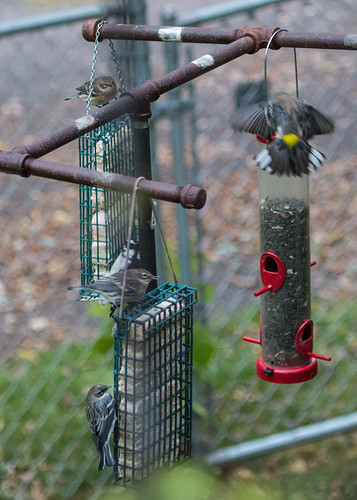 |
| White-throated Sparrows, one Fox Sparrow, and several White-crowned Sparrows cover the ground in my own backyard, where I scatter white millet for them. Not one sparrow has hit my windows this year. |
Right now, the western end of Lake Superior is in the midst
of a massive migration fall-out. Everyone seems to be noticing—I’ve been getting
lots of calls about it, and it made Sam Cook’s October 5th blog. And on
October 7, Sam wrote a front page article in the Duluth News-Tribune about the dark side of this
fall-out—the huge number of birds being killed in collisions with windows,
cars, and even bicycles. I was so concerned that on October 2, I started a
webpage, birdcollisions.blogspot.com, where people can report birds killed at
windows in Duluth and Superior.
This is hardly the first time we’ve had a huge fall-out here,
and whenever we do, there is a lot of mortality. On the September 25 entry of
my 1994 book, For the Birds: An Uncommon Guide, I mention one
of these migration events:
On frosty mornings when the soil is
warmer than the air, yellowrumps and Palm Warblers gather on lawns and
roadsides, picking up insects and being picked up by cats in huge numbers. When
they’re grounded under these conditions, they’re also killed by cars. On
September 25, 1991, in the “Great Highway 61 Warbler Massacre,” thousands of
inexperienced pedestrians were killed as they followed the lakeshore and were
attracted to the sun-warmed pavement. Warblers are fairly good at evading most
falcons, but they’re simply not equipped to deal with the Ford variety.
That same fall of '91, my son Tommy was a kindergartener. He
and I picked up dozens of warbler carcasses on our walks to school. In a single
morning, we found 17 dead Palm and Yellow-rumped Warblers on a two-block stretch,
all of which had been killed by a single neighborhood cat—that’s what gave me
my first big push to start fighting for a cat leash law in Duluth.
Duluth is at the epicenter of a major migration flyway, but
we don’t get these huge events very often. What caused this year’s fallout? There
seemed to be two different weather factors at play.
First, this year we had a very
cold, late spring, which probably delayed nesting for a lot of birds, keeping
them north longer than what would be ideal. Lots of people noticed how late hummingbirds
remained—I’ve often had a straggler or two in late September and even October,
but never before had I had daily
hummingbirds through September 20—the vast bulk of them are usually gone by the
first week of September. It’s not
our wonderful backyard habitat or feeders holding them longer than
normal—hummingbirds and other nectar- and insect-eating birds tend to migrate
when their most important foods are especially abundant, to fuel their flights.
Rather than enticing them to stay, abundant food actually encourages them
to bulk up and leave. The late hummers included adult females who needed to recover
from their last, late nesting, and the result of all those late nestings—lots
of young hummers. The huge number of late warblers were almost certainly the result of
late nesting, too.
That explains the late timing of migration and why so many
birds are on the ground—by this late, the bulk of caterpillars in trees are
gone, leaving insectivores to search for their food elsewhere.
 |
| I've had as many as 12 Yellow-rumped Warblers in my suet and peanut butter feeders at the same time this week. This is not a typical visitor at bird feeders, but they're desperate. |
The ground temperature can be quite a bit warmer than the air temperature, especially during high-wind days. But in many
years with late nestings, birds still manage to slip by in much smaller numbers—at least as far
as we notice. What's different this time?
The massive numbers of migrants around here are almost certainly the result of so many days of westerly winds—exactly the conditions for
pushing maximum numbers of migrating birds from northern Canada to somewhere along Lake Superior—from
there, the birds follow the shoreline, at least during their daily movements as
they feed, rest, and mosey in the right direction.
Sadly, when temperatures
are cooler and it's windy, birds require more calories just to maintain their body temperature, not
even counting all the added calories they need to build up their fat reserves for
long nocturnal flights. They’re so focused on food right now that they can’t
afford to pay attention to unfamiliar hazards like cars and bikes. And so, despite the thrilling birding conditions, it’s a mess
out there.